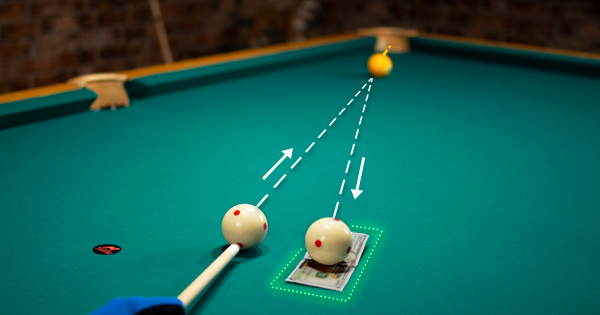
In this article, we combined questions about drawing the cue ball answered by the great Tom Simpson in his Ask The Master column. Below, Tom provides answers to three specific questions about draw.
The first is from a player who had trouble with miscuing and launching the cue ball on longer draw shots. The next question was submitted by a player who wasn't getting enough draw. And the final question was from a player who wanted pointers on how to be more precise. The goal is for players of all levels to relate to and learn from these discussions in one cohesive article. Enjoy!
Miscuing (Launching the Cue Ball) on Longer Draw Shots:
Ask The Master: "I have little problem with shorter draw shots. However, when I am on a longer draw shot, which takes more power and follow through, I frequently miscue and loft the cue ball off of the table. I must be dipping the cue tip downwards when contacting the cue ball?" Sincerely, Jim C.
As you correctly realize, your tip is dipping into the cloth and scooping or lofting the cue ball. This is happening because your fundamentals are breaking down when you shoot hard. It's also happening when you try to "do" something rather than letting the stick do its job. Pretty common. Let's look closer at the most common causes of tip dipping: wrist curling, raising the elbow and jumping out up during the hit stroke.
1. Curling the Wrist
Wrist curling can happen because you unconsciously curl it to get farther through the ball to get good action. Curling allows you to stroke farther before you run out of stroke room and bang into your chest. Curling can also be caused by clenching, which many players do on hard draw strokes. Or it could be that curling is what you do when you shoot hard. It just doesn't come up as often enough to realize it's a fundamentals flaw. Whatever, the cause, if that's what it is, let's fix it. Start with my PoolDawg piece: "How Can I Stop Twisting my Wrist?"
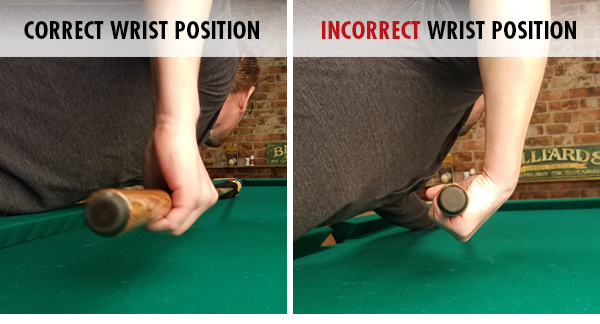
2. Raising the Elbow
Raising the elbow happens when your arm tenses up and your elbow resists opening. If your elbow is rigid, your stroke will swing in the shoulder, raising the butt off the cue. Relax. Get your elbow oiled up and working. Pull the cue back smoothly without jerkiness.
3. Jumping Up
Jumping up is what we call it when a player stands up during the hit stroke. If you're rising up and your elbow comes up, so does the butt of the cue.
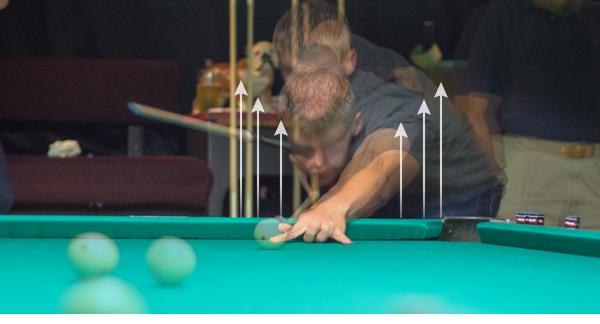
Advice: Practice draw progressively. Start with what you can easily control and incrementally work your way towards longer shots, more draw distance, etc. This will allow you to discover some of your necessary changes. Use a light grip, fluid elbow, and smooth stick movements. Don't elevate.
More Advice: Don't shoot the shots you can't do.
BEST ADVICE: From one of the all-time greats, Luther Lassiter, said something close to this about big draw: "I loosen my grip, then when I'm stroking I loosen it again, and finally, I loosen again for the hit."
 Frank Says: "Check your tip contact point with a Jim Rempe Training ball. Clean the ball, put some fresh chalk on your tip and hit a draw shot. You'll be able to see if the chalk mark is as low as you think it is. You may be surprised by the results!"
Frank Says: "Check your tip contact point with a Jim Rempe Training ball. Clean the ball, put some fresh chalk on your tip and hit a draw shot. You'll be able to see if the chalk mark is as low as you think it is. You may be surprised by the results!"
Not Getting Enough Draw
Ask The Master: I've started shooting pool again after a long, long leave of absence. I'm not too bad with making the shots, but cannot put any spin on the ball. I keep my cue roughed and chalked, but only occasionally do I get any spin. Can you recommend anything to help?
I have to assume you're talking about backspin here. The problem usually is that you are not hitting low enough on the cue ball. If you were, you'd see backspin. Maximum low is lower than most players think. But even more critically important, most players who have not had training drop their stroke elbow during the hit stroke. Yes, this is the natural human move, but it's not the smart move for pool players. If you drop your elbow on the way to the hit, the tip comes up. This leads to no draw and no backspin.
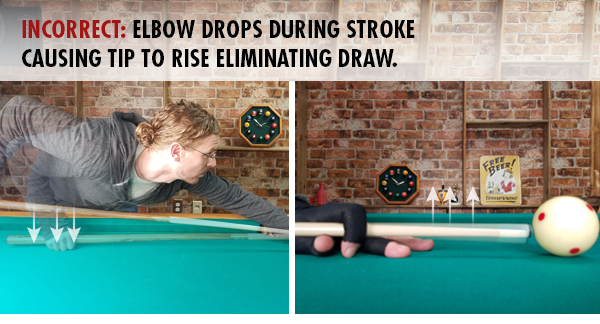
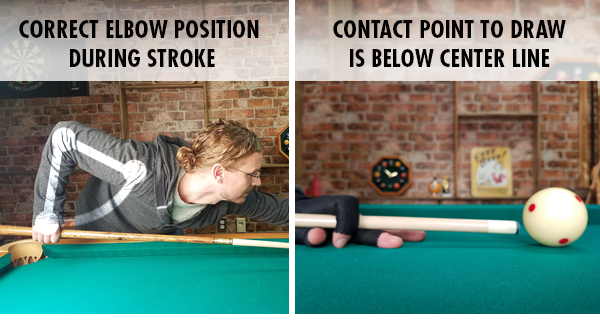
Bottom Line: Try starting with your tip on the cloth at the base of the cue ball and raise it slightly, rather than lowering from higher on the ball. Most good instructors teach this fundamental stroke motion. I developed a training aid that helps players quickly learn this specific move. It's the Stroke Groover, and is available through PoolDawg.com.

Progressive Practice Drills for Drawing with Precision
Ask The Master: What is the best way to learn to draw the cue ball with precision?
The short answer is PRACTICE. The longer answer is PROGRESSIVE PRACTICE. Assuming you've already got your stroke working well, so you actually touch the cue ball where you mean to, and you can fairly reliably hit at the speed you want, it's time to calibrate your body for precision draw.
Draw is "art" since you have to break the friction with the cloth. I can tell you the factors (the science), but how you put it together in your imagination and how you execute it (the art) is your dance. Draw is hard to control. Follow, or roll, is easy. We say, "Draw for show; follow for dough" for a good reason.
Draw is caused by hitting below the equator of the cue ball. Lower gets you more RPMs of backspin. Hitting harder at the same spot yields even more backspin. Variations in how sticky the cue ball is and how fast the cloth is, also contribute to the problem by affecting how long it takes for the backspin to wear off of that skidding cue ball.
Progressive practice is highly efficient. Set up a straight-in shot with the cue ball one foot from the object ball. Draw the cue ball back to where it started. When you succeed, move the cue ball to a two-foot distance and again draw back one foot. Continue increasing the distance until you've succeeded with your one-foot draw to five or six feet.
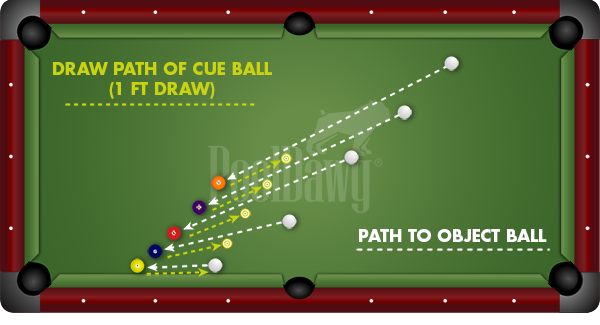
Now, start over with the same setup and draw two feet on every shot. Then, do the exercise drawing three feet every time. This is the general progressive idea. You can quickly calibrate yourself to be able to more consistently and precisely shoot the wide variety of speeds, spins, and distances we need to deal with in pool.
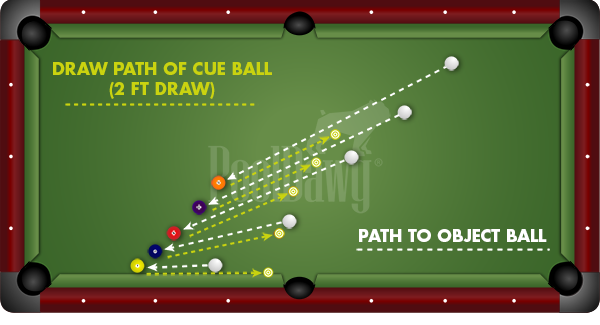

Key Takeaways:
- Keep a straight, uncurled wrist.
- Maintain your elbow height and don't jump up.
- Oil the elbow up, keep a loose grip, and focus on a slow pull back.
- Practice makes perfect. Try out the drills above and watch your draw improve significantly.
- RELATED ARTICLES
- Luck of the Draw – By Liz Ford
- Draw for Show, Follow for the Dough – By Mikey Verkruyse
- Drill for Precise Draw Shots – By Mark Finkelstein